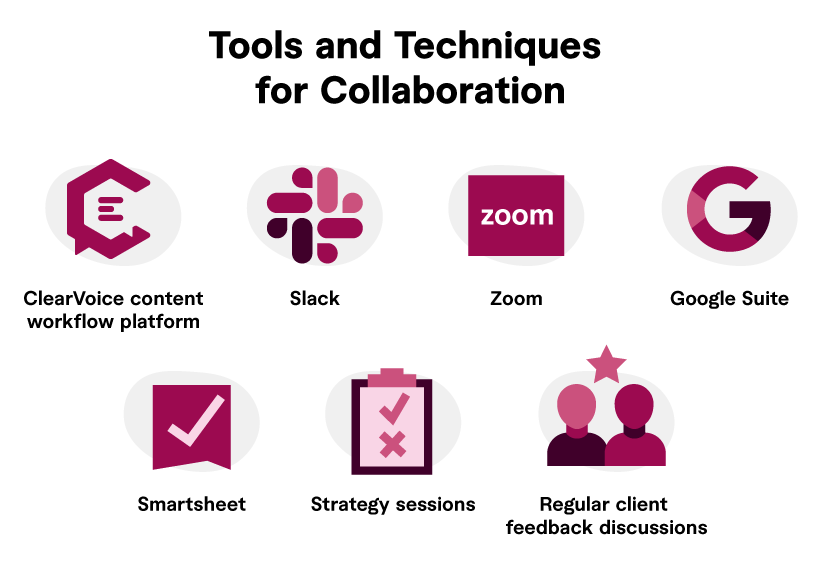When it comes to teams and developing a content strategy, we can perhaps all agree: Silos hinder communication flow, stifle creativity, and make executing a unified content vision a major problem.
Formulating and implementing a content strategy is an endeavor that requires team participation. Without collaboration, the price to pay can be hefty: Inconsistent messaging confuses audiences and dilutes your brand’s identity.
In this guide, we’ll talk about:
- The challenges of content silos
- The need for collaboration when developing and executing content strategies
- How to encourage collaboration among cross-functional teams
- How ClearVoice approaches collaboration
The Challenge of Content Silos in Organizations
But first, what are content silos?
You may have heard of content silos for SEO. While they come with notable benefits — specifically, creating clear sections or themes of related content on your website, making it easier for search engines and users to understand what your website is about — many SEOs prefer the pyramid site structure over it.
In a silo architecture, related topics are grouped together, and content created around these topics can link to one another. They can’t, however, link to content in other silos, even when there’s a clear topical overlap.

In the context of content strategy development, content operates in silos when confined within departments or roles. For many large enterprises, content silos can be crucial to getting things done. The problem rears its ugly head when departments start taking ownership of their own content, voice, and strategy — instead of working with other teams to deliver a consistent, cohesive narrative and experience.
Identifying content silos
Content silos emerge as a result of different people or departments managing content initiatives independently. They can take many forms:
- Departmental: Different departments create and manage their own content. Collaboration is minimal. For example, the marketing team creates blog content, while the sales department creates product-specific collateral.
- Channel-specific: A social media team creates content for social media, while a separate blog team writes content for the website.
- Product-centric: Each product team creates content exclusively for their respective products without considering how each contributes to the overall brand story.
- Campaign-specific: Campaigns don’t align with the broader content strategy and lack lasting impact.
- Geographic: A global company has different marketing teams for different regions, each producing content customized for local audiences.
- Audience-specific: A separate team creates content for each of the company’s buyer personas.
- SEO-centric: Content focuses on keywords and search engine visibility, overshadowing the need to provide valuable, shareable, and link-worthy content.
Impact of silos on content strategy
The impact of content silos can be far-reaching:
- Miscommunication: In companies with content silos, effective sharing and communication mechanisms may not be in place. This can result in misunderstandings, lack of strategic alignment, and duplicated efforts.
- Inefficient resource utilization: Different teams creating content independently spread resources thin. This can hamper a company’s ability to agilely respond to changing market conditions.
- Missed cross-channel opportunities: When content teams focus solely on their designated platforms, they miss opportunities to synchronize messaging with other teams and maximize reach.
- Lack of consistency: Content silos can lead to messaging, tone, and style inconsistencies. Contradicting narratives leave customers confused and distrustful of the company. In the case of multinational companies with multiple marketing departments, although localization is necessary, global brand messaging can suffer without collaboration.
Collaborative Content Strategy: Why Teamwork Makes the Dream Work
You’ve heard it a thousand times — two heads are better than one. In the case of companies building a content strategy, different departments working together are akin to pieces falling into place like a well-coordinated puzzle.
This collaborative approach brings a wealth of skills, knowledge, and perspectives to the table, ensuring your content isn’t limited to just one point of view. Content production becomes more efficient. No more bottlenecks and unnecessary duplication of efforts. Everyone has access to necessary tools and information, making consistently producing high-quality content much easier.
Plus, collaborative environments foster real-time communication and feedback. This allows companies to quickly pivot and adapt their content strategies to stay in tune with emerging trends and shifting consumer behaviors.
And because collaboration facilitates the creation of a unified brand voice, messaging stays consistent across channels, aligning the efforts of various teams (marketing, sales, product, customer support, etc.) with overall business goals.
Strategies for building a collaborative content environment
Effective collaboration, however, doesn’t just happen on its own. It needs an environment where it can thrive and bear fruit. This means implementing strategies such as:
- Keeping communication lines open: Schedule regular meetings to share updates, discuss projects, and address any issues. This ensures everyone is on the same page.
- Using digital collaboration tools: Project management, instant messaging, and collaboration tools like Asana, Skype, and Slack enable teams to share documents, track projects, streamline communication, and brainstorm content ideas.
- Establishing clear roles and responsibilities: This ensures accountability and prevents duplication of efforts.
- Encouraging knowledge sharing: Provide a central knowledge base or repository where team members can contribute lessons learned, insights, or best practices. This creates a culture of continuous learning.
- Offering cross-training opportunities: Provide training sessions or workshops that allow team members insights into the functions and processes of other departments. This can help them understand the company’s operations more holistically.
- Conducting joint strategy or planning sessions: These ensure diverse content perspectives are considered, and that future campaigns align with overall business objectives.
- Implementing regular feedback sessions: Ask team members about what’s working and not working about the collaborative process. Perhaps the reward system is misaligned. Or maybe certain people resist change and perceive collaboration as a burden. Use these insights to address any challenges.
How ClearVoice Preserves Collaboration
At ClearVoice, collaboration is a core driving principle — and this commitment extends beyond internal teams to encompass the freelancer network, clients, partners, and the communities it serves.
Collaborative freelancing, ClearVoice’s brand of collaboration, involves individual freelancers banding together to form a team of creatives — writers, editors, graphic designers, etc. — to work on projects, either on a project basis or for the long term. This has many significant benefits.
Angela Tague, one of ClearVoice’s many talented marketing writers, says of working with a team: “When I started collaborating with production teams at digital marketing and advertising agencies, I discovered I thrive when joining creative forces with content strategists, editors, designers, and marketing directors. Bouncing ideas off one another was not only career-building, it also made me feel integral to the full content creation process, not just the copywriting segment of the workflow.”
Tiffany Verbeck, a ClearVoice writer and producer, knows firsthand that freelancing can be lonely when you go it alone, “like floating on a rowboat in the middle of the ocean with no one else in sight.” One solution to isolation that she highly recommends is joining a team.
ClearVoice’s clients are reaping the benefits as well.
GLOBO, a language solutions company, increased blog content views by 200 percent after partnering with ClearVoice. According to Kelsey Walker, GLOBO’s content strategist: “Partnering with ClearVoice allowed us to increase our thought leadership content and has equipped us with a larger team. It’s like having an extra limb.”
ClearVoice’s partnership with Tailwind, a social media scheduling app for Instagram and Pinterest, helped increase weekly blog output by 500 percent and overall blog traffic by 9X. Kristen Dahlin, Tailwind’s marketing manager, has this to say: “We genuinely could not have hit and exceeded our goals to establish a presence and an authority in our spaces without the ClearVoice platform.”
Seema Kumar, founder and CEO of SEEMA, a global platform for South Asian women, previously found hiring freelancers “like a game of Whack-a-Mole.” But with ClearVoice’s team of writers, “ClearVoice allowed me to scale my dream,” she says.
Tools and techniques for collaboration
So, how does ClearVoice keep collaboration alive and well among teams? By using various tools and techniques, including:
- ClearVoice content workflow platform: Built specifically for content teams, this proprietary platform includes features like easy-to-use dashboards, brand profiles, collaborative content workflows, dynamic content calendars, in-app messaging, and freelancer management tools.
- Slack: Aside from writers, each ClearVoice managed account is composed of a success manager, a talent manager, a managing editor, and a content producer. With Slack, they can discuss updates from clients, freelancer performance, issues with assignments, and other related topics.
- Zoom: Zoom is integral to regular check-ins with clients, interviews with subject matter experts, producer training sessions, strategy sessions, and other types of meetings.
- Google Docs, Sheets, and PowerPoints: Because these types of documents can easily but securely be shared with various stakeholders, ClearVoice teams and clients use them to share notes, content briefs, presentations, and other resources necessary for content creation.
- Smartsheet: This helps internal teams keep track of the types of content to deliver within a specific time frame.
- Strategy sessions: ClearVoice experts conduct these sessions with clients to thoroughly understand their pain points and content requirements.
- Regular client feedback discussions: Managing editors and success managers relay to producers what clients say about completed assignments — and recommend next steps to address any issues, if any. This way, ClearVoice teams can consistently deliver high-quality content.
Strengthen Your Content Strategy with Collaboration
To craft a strategy that meets business goals, content collaboration is a must-have, a strategic imperative. By harnessing the collective power of diverse minds and skill sets, you can produce content that far exceeds expectations.
Speak with an expert content strategist at ClearVoice today to get started.







